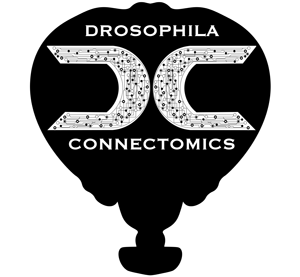The fruit fly's olfactory system - a connectomics approach
Our group focuses on the olfactory system of the fruit fly – Drosophila melanogaster. Fruit flies exhibit both innate and learned responses to odours. For example, flies will instinctively approach food sources by smell, while avoiding danger signals such as the smell of their main parasitoid enemies, Leptopilina wasps. Flies also exhibit associative learning and can be taught to approach or avoid previously neutral odours in response to a sugar reward or punishing electric shock.
The fruit fly therefore offers an excellent model system to begin to understand the neural circuits that underlie both innate and learned behaviours.
The olfactory circuits in Drosophila
In the fly brain, the first and second order neurons that make up these circuits are well described.
Firstly, specific odorant molecules activate olfactory receptor neurons (ORNs) in the antennae and maxillary palps of the fly. These ORNs transmit this information to the primary olfactory centre – the antennal lobe (AL) – where ORNs of the same type pool information in the same region (glomerulus). From here, projection neurons (PNs) maintain these distinct odour channels as they relay the signal to two major regions – the lateral horn (LH) and the mushroom body (MB). The LH is thought to mediate innate responses, while the MB is mainly involved in learning and memory and state-dependent behaviour (Masse et al., 2009, Owald et al., 2015a).
The MB is made up of ~2000 Kenyon cells (KCs), which receive seemingly random input from the population of PNs. These KCs then connect to MB output neurons (MBONs) that are the main output of the MB. Interestingly, the properties of these KC-MBON synapses can be modified by numerous dopaminergic neurons (DANs) that innervate the MB (Hige et al., 2015, Cohn et al., 2015). These DANs signal behavioural significance, making them essential for associative learning in response to odours (Aso et al., 2016, Owald et al., 2015a). Seventeen compartments have been recognised in the MB (based on the arborisation of the DANs and MBONs) and these act as distinct units that regulate different behavioural outputs (Aso et al. 2014a, Aso et al. 2014b, Aso et al. 2016, Owald et al. 2015b).
Questions we are addressing
There are, however, still many outstanding questions. For example, although it is known that the projections of PN types in the LH are stereotypical (Marin et al. 2002, Jefferis et al. 2007), the circuits downstream of these neurons are still unknown. In the MB, the circuits that feed into the DANs (affecting plasticity), the targets of the MBONs and how MBONs ultimately govern motor behaviour are not well understood. Furthermore the interactions between pathways mediating learned and innate odour responses remain poorly understood.
To address these questions, our group aims to reconstruct the olfactory circuits at synaptic resolution – mapping all the individual neurons involved and their connections to each other (Saalfeld et al., 2009, Schneider-Mizell et al., 2016). To do this, we are making use of a recently completed electron microscopy volume of an entire adult fly brain (collected at Janelia Research Campus) (Zheng et al., 2018).
This project will contribute to the ultimate goal of creating a high resolution map of the entire fly brain (a ‘connectome’). In adidittion to our group, many others are reconstructing other neurons in this dataset. When complete, it will be the largest electron microscopy connectome collected to date. Working closely with another team in the US, as well as experimental groups in Oxford and Cambridge – we hope to gain a comprehensive understanding of the circuits involved in processing olfactory information.
You can see our publications here.
Relevant Literature
Masse, N.Y., Turner, G.C., and Jefferis, G.S.X.E. (2009). Olfactory Information Processing in Drosophila. Current Biology 19, R700–R713.
Owald, D., and Waddell, S. (2015a). Olfactory learning skews mushroom body output pathways to steer behavioral choice in Drosophila. Current Opinion in Neurobiology 35, 178–184.
Hige, T., Aso, Y., Modi, M.N., Rubin, G.M., and Turner, G.C. (2015). Heterosynaptic Plasticity Underlies Aversive Olfactory Learning in Drosophila. Neuron 88, 985–998.
Cohn, R., Morantte, I., and Ruta, V. (2015). Coordinated and Compartmentalized Neuromodulation Shapes Sensory Processing in Drosophila. Cell 163, 1742–1755.
Aso, Y., and Rubin, G.M. (2016). Dopaminergic neurons write and update memories with cell-type-specific rules. eLife 5, e16135.
Aso, Y., Hattori, D., Yu, Y., Johnston, R.M., Iyer, N.A., Ngo, T.-T., Dionne, H., Abbott, L.F., Axel, R., Tanimoto, H., et al. (2014a). The neuronal architecture of the mushroom body provides a logic for associative learning. eLife 3, e04577.
Aso, Y., Sitaraman, D., Ichinose, T., Kaun, K.R., Vogt, K., Belliart-Guérin, G., Plaçais, P.-Y., Robie, A.A., Yamagata, N., Schnaitmann, C., et al. (2014b). Mushroom body output neurons encode valence and guide memory-based action selection in Drosophila. eLife 3, e04580.
Owald, D., Felsenberg, J., Talbot, C.B., Das, G., Perisse, E., Huetteroth, W., and Waddell, S. (2015b). Activity of Defined Mushroom Body Output Neurons Underlies Learned Olfactory Behavior in Drosophila. Neuron 86, 417–427.
Marin, E.C., Jefferis, G.S.X.E., Komiyama, T., Zhu, H., and Luo, L. (2002). Representation of the Glomerular Olfactory Map in the Drosophila Brain. Cell 109, 243–255.
Jefferis, G.S.X.E., Potter, C.J., Chan, A.M., Marin, E.C., Rohlfing, T., Maurer Jr., C.R., and Luo, L. (2007). Comprehensive Maps of Drosophila Higher Olfactory Centers: Spatially Segregated Fruit and Pheromone Representation. Cell 128, 1187–1203.
Zheng Z, Lauritzen JS, Perlman E, Robinson CG, Nichols M, Milkie D, Torrens O, Price J, Fisher CB, Sharifi N, Calle-Schuler S, Kmecova L, J. Ali I, Karsh B, T. Trautman E, A. Bogovic J, Hanslovsky P, s.X.E. Jefferis G, Kazhdan M, Khairy K, Saalfeld S, D. Fetter R and Bock D (2018). A Complete Electron Microscopy Volume of the Brain of Adult Drosophila melanogaster. Cell 2018
Saalfeld, S., Cardona, A., Hartenstein, V., and Tomančák, P. (2009). CATMAID: collaborative annotation toolkit for massive amounts of image data. Bioinformatics 25, 1984–1986.
Schneider-Mizell, C.M., Gerhard, S., Longair, M., Kazimiers, T., Li, F., Zwart, M.F., Champion, A., Midgley, F.M., Fetter, R.D., Saalfeld, S., et al. (2016). Quantitative neuroanatomy for connectomics in Drosophila. eLife 5.

